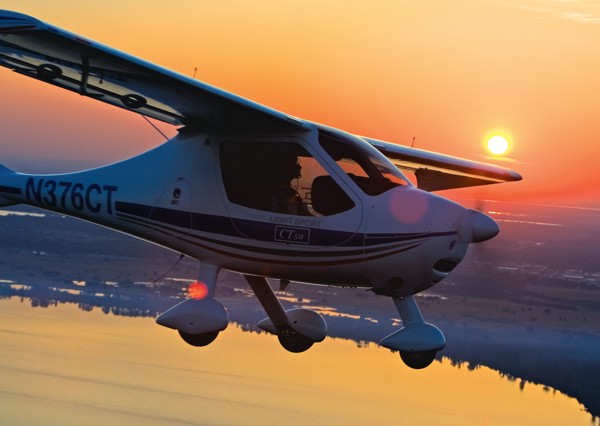
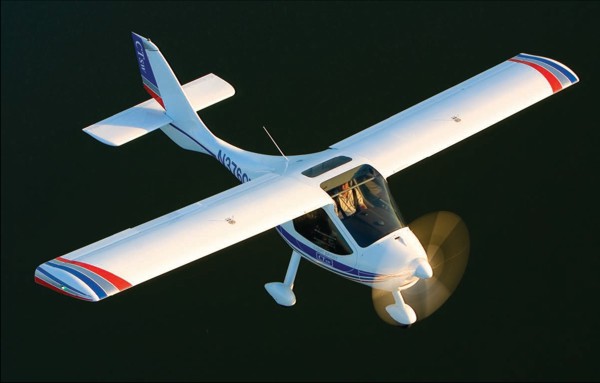
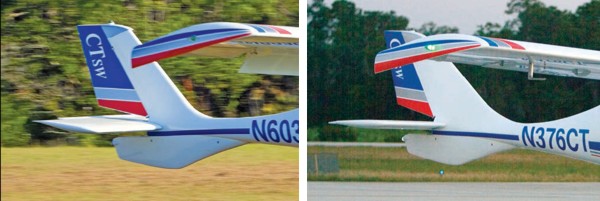
To improve the aircraft’s handling qualities, Flight Design increased the size of the leading edge of the vertical stabilizer-compare the diff erence in these photos. It also
added a full-span anti-servo tab to the full-fl ying stabilator.
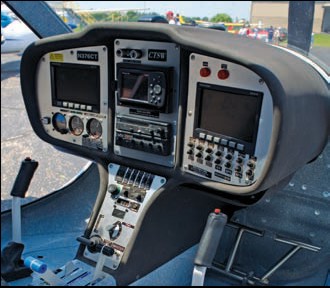
The instrument panel on the 2006 CT was also modifi
ed, changing it to a three-section panel, with two
panels angled toward the center panel. A satin-aluminum
fi nish gives the panel a distinctive appearance
and reduces glare. The generous size of the panel
area accommodates a wide range of instruments,
depending upon the aircraft’s mission.
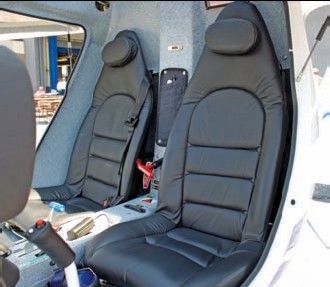
The seats in the 2006 CT are also more refi ned and extend
higher up the back to provide more support and
a headrest. They’re available in black or brown leather.
The seats can be adjusted fore and aft as well as
up and down to accommodate diff erent sized pilots.
The 49-inch wide cockpit provides plenty of room for
two occupants.

The Flight Design CT currently leads the LSA parade
with more than 85 aircraft delivered to customers
since the aircraft earned S-LSA approval in April of
2005. Flight Design of Germany markets the aircraft,
which is built in the Ukraine. Flight Design USA of
South Woodstock, Connecticut, imports the aircraft
into this country.

The pull handle for the BRS ballistic chute is located
on the aft bulkhead between the seat backs. Below
the handle is the rudder trim wheel and forward of
that, on the console between the seats, is the aileron
trim wheel.

Baggage compartments, on either side of the aircraft,
can accommodate up to 100 pounds of baggage,
as long as it’s within the aircraft’s total weight
and balance requirements. The BRS ballistic chute is
housed in this area, too.
In the 15 months since the first two special light-sport aircraft (S-LSA) were introduced
at the Sun ‘n Fun Fly-In in Lakeland, Florida, a wave of S-LSA have taken to the
sky. The number delivered to customers is approaching 500 aircraft — and climbing as
quickly as factories can produce and deliver them. The years ahead should see a sharply
increasing number of LSA flying in America.
The good news for pilots is we won’t
just have more LSA, we’ll have better
ones as designers modify and improve
aircraft based on customer input and
service history. That’s one of the benefi
ts of consensus standards versus
type certification-manufacturers
can cram more features into the airplanes
and factories may refine production
techniques without undergoing
costly recertification. The best
news is we don’t have to wait. “New
and improved” LSA are here now.
The 2006 CT
Because of its distinctive profile, the
Flight Design CT is one of the most
recognized S-LSA flying. Some of the
design’s success comes from an effort
by its German producer to make
the CT a better package, as witnessed
by its introduction of a refined 2006
model. Flight Design Germany has
been aided in this effort by its U.S.
importer, Flight Design USA, and the
experienced network of dealers that
Flight Design USA has created.
And the European-born CT has
evolved to meet the expectations of
American pilots. Just prior to Sun ‘n
Fun 2006, I flew both the 2005 and
2006 model CTs, courtesy of the folks
at Sebring Aviation, the Flight Design
USA distributor for the southeastern
United States.
Back-to-back flights in the two
models offered a clear comparison
and updated my previous experiences
flying the CT. Close observers should
quickly note:
Two changes to the tail surfaces.
Most noticeable is an enlarged area
on the leading edge of the vertical
stabilizer. Next, the full-flying stabilator
has an anti-servo tab that runs
full span.
A new instrument panel configuration
is standard. A wider, flat-gray
panel is now divided into three segments
with satin-finish aluminum
faces, with two slightly angled panels
flanking a center panel.
The 2006 model’s seats rise higher
and offer some head support.
The pilot can now trim the aircraft
in all three axes using trim
wheels, a feature common only on
more expensive general aviation (GA)
aircraft.
The wings of the two models are
exactly the same, employing the
same flaperons.
After reacquainting myself with
the characteristics of the 2005 model
in flight, I went aloft in the 2006
model with its larger vertical tail and
full span anti-servo tab. The aircraft
offered by Sebring Aviation had a
decked-out panel to make most pilots
envious.
Regardless of its aerodynamic improvements,
the larger vertical tail on
the 2006 model visually fills out the
aircraft’s profile, making the tail volume
conform better to the fuselage.
The reshaped tail blends nicely with
the ventral (below-the-fuselage) fin.
Shape, like color, is decidedly personal,
but I believe most aviators will
find the curves of the 2006 CT to be
appealing.
I enjoyed flying both ’05 and ’06
models even more than I expected.
The soaring enthusiast in me loved
the original long-winged CT’s superb
glide, but I found it more work coordinating
rudder and ailerons in the
older model than in either shorterwinged
’05 and ’06 models. Surprisingly
the shorter wing configuration
still gives the CT plenty of loft on approach
to landing, a reported 14-to-1
glide. The 2006 CT has become a refi
ned flying machine.
Lots of Elbow Room
The cockpits of many European-designed
airplanes are too tight for larger
Americans. Everybody likes to have
a little extra room, especially on longer
flights. In the CT’s 49-inch-wide
cockpit, John and I, both of average
build, had plenty of room. I had less
at my feet because the nose of the aircraft
tapers, but I didn’t feel cramped.
The CT’s seats adjust fully aft, which
allowed me to extend my legs fully.
The seats in the 2006 CT are also
softer and more comfortable than
earlier models, and it felt like they
offered more lumbar support. The
seats also extend up higher, supporting
your head, something the seats
on the earlier models did not do.
Fore and aft adjustment plus height
adjustments are available, but you
must make these adjustments on the
ground where you can visually ascertain
that the locking pins are properly
seated in the adjustment rail holes.
Cockpit Refinements
LSA are not ultralights. Ultralights
want to be simple and inexpensive,
and fewer instruments are employed
to stay light. But buyers of LSA are
often GA pilots accustomed to fully
equipped panels. Recognizing this
customer demand, the 2006 CT boasts
enlarged space for avionics. The 2005
CT had analog gauges while the 2006
model I flew was all digital. Though a
digital cockpit may offer more information,
many pilots feel they pick up
on data quicker from analog gauges.
Yet digital instruments, like the CT
airframe, keep getting better, and analog
pilots will adapt.
Other cockpit refinements include
a smaller flap switch in the ’06, and
this turned out to be good. I tended
to over-control the larger lever, flipping
it inadvertently back and forth
between two settings, which confused
the system. A light-emitting diode
(LED) readout clearly shows the
flaps setting.
I am highly supportive of the BRS
emergency parachute system that’s
standard equipment on the CT (as a
former BRS employee, I should be),
but I have never been a big fan of the
parachute handle’s location on the aft
bulkhead of this aircraft. While that
assures a direct routing for the activating
housing, it requires the pilot
or passenger to reach backward and
make a substantial pull of a handle at
an awkward angle. A better position
might be to have the handle mounted
on the instrument panel, but that
would require a long activating housing.
Pilots will definitely want to rehearse
the parachute handle pull motion
and instruct passengers about
the operation.
In addition to its challenging
placement, the parachute handle also
somewhat interferes with the aileron
and rudder trim wheels, which are
located nearby. Pilots will acquire a
natural feel for them eventually, but
they’ll need to confirm what they’re
engaging the first few times they fly
the 2006 CT.
To open the
cockpit door from
the inside, push
the doorknob toward
the outside
slightly and then
release the three
pins that secure
the door, which
are hidden by
the interior door
finish. (Flight Design
also offers a
right-side photo
door for those interested
in pursuing such a hobby.)
The Mecaplex sliding window vents
let in the most air when you close
the sliding mechanism and use the
small, angular flip-out vent. For flying
in cool months, CT comes with
standard cabin heat, or you can order
a higher output system for cold
climates.
As you prepare to start the CT,
you’ll run into another good safety
idea. Engineers positioned the fuel
shut-off lever so you cannot insert
the starter key with the fuel selector
in the off position. You raise the fuel
shut-off for flight (logically) and then
put your key in and start the engine.
As in most GA aircraft, you use the
key switch to check magnetos.
Don’t Expect a Long Ground Roll
As usual, the 100-hp Rotax 912S
snapped to a start when I turned the
key. After assuring our seat belts were
latched and the doors were properly
closed, John and I taxied for takeoff.
Rudder steering in both ’05 and ’06
models is solid.
On Sebring Airport’s long, wide,
and unobstructed runways, we had
no need to max out take-off performance.
Yet even with gentle controls,
the CT left the ground with enthusiasm.
I doubt our first roll was 500
feet, and we weren’t even trying to
take off quickly. Off the runway,
I noted climb at more than 1,500
fpm, a rate that settled around 1,100,
though John and I were not flying at
full gross weight. Most of this evaluation
flight was done at low altitude-
about 1,200 feet MSL.
Before we took the CT to its top
speed, we experimented with slow
flight. Pulling the power liberally, we
waited for 63 knots before deploying
the flaps. The LED flap indicator
blinks your setting
until the flaps are
deployed to the
position selected.
Once your chosen
setting is reached,
the number glows
steadily. The CT is
smart; John told
me that if you
select 40 degrees
of flaps while flying
too fast for
safe deployment,
a sensor reads the
amperage load on
the flap motor and stops the flap deployment
if the load is too high.
As we practiced a few touch-andgoes,
I made approaches in the 2005
CT using 40 degrees of flaps while doing
a slip that put one rudder pedal
on the floor. The plane exhibited
excellent handling throughout this
exercise.
My last landing was done with
only 15 degrees of flaps, and the 2005
CT simply did not want to drop out
of the sky. It demonstrated a slow, unpowered
descent that would buy any
pilot time should the engine quit.
The landing gear on the 2005 model
offered smooth and stable ground operations, and both model years exhibited
superb taxiing characteristics,
almost like driving an automobile. On
the 2006 model, however, I observed
a roughness in the ride as soon as we
landed, possibly resulting from some
gear leg harmonic. The roughness disappeared
as we slowed, suggesting it
was not simply an out-of-balance tire.
(John had checked that possibility.)
Even though I’m experienced with
hand brakes, I found it a bit cumbersome
attempting to work the hand
brake and the throttle simultaneously
with my right hand on the brake and
my left hand on the throttle. Later I
developed a technique of using my
right forearm to assure holding the
throttle at idle, which is where you’d
place it before activating the brakes.
Sweet, Light Handling
As we said earlier, one of the most
visible changes to the 2006 CT is its
enlarged vertical stabilizer, but how
does it help handling? During his
evaluation of the new tail on the
2006 model, Flight Design President
Tom Peghiny disturbed the controls
and watched the airplane’s recovery
to straight and level flight. My method to gain a feel for the larger vertical
stabilizer was to note the speed and
accuracy of recovery from slips. The
CT comes out of the deepest slip authoritatively.
The CT uses a stabilator-a fullmoving
elevator and horizontal
stabilizer surface. Compared to the
earlier CTs I’d flown, I detected
less hunting
of the nose
and a more
dampened response
to pitch
changes-attributes
that
should make
cross-country
flying easier on
pilot and passenger.
A longer
anti-servo
tab makes this
surface much
more effective.
(Note that an anti-servo tab works
the opposite of a trim tab, making
the free-moving stabilator not as
light in pitch response. A trim tab
relieves control pressures whereas an anti-servo tab increases control
forces on aircraft with light pitch
response.)
When the anti-servo tab was extended,
it increased elevator forces
to bring them in better harmony
with the ailerons. I especially noticed
this when exiting a deep slip.
I had more feel from the 2006 CT’s
joystick than I
did on the 2005
model. Commensurately,
in the 2006 CT
the slip is not
quite as deep
as in the 2005
model, proving
the larger vertical
stabilizer is
at work.
Compared
to the longwinged
version
with a smaller
tail and smaller anti-servo tab, the
2006 CT has significantly improved
control feel and harmony. Keeping
the ball centered is now much easier
than it was in the older versions.
Carbon Fiber Performer
Since its introduction in the mid-
1990s, the CT has looked the part of a
performance machine. Like Jim Griswold’s
distinctly egg-shaped Questair
Venture, performance comes with
this fuselage configuration.
John and I flew the 2006 CT to
5500 rpm where we averaged 119
knots indicated air speed (IAS) on
an upwind and downwind run. This
translated to 125 knots true airspeed
(TAS) on the day we flew together.
The fastest speed was achieved with
the flaps reflexed (curved upward) to
the 6-degree setting. This sailplane
control helps broaden the CT’s speed
range. John stated that not using the
reflex would lower cruise by 2 to 3
knots.
When I wasn’t trying to evaluate
the CT’s upper-end performance, I
tended to fly it in the low 5000 or
high 4000 rpm range. I felt comfortable
at this setting. The CT was quieter
and smoother. When you raise the
rpm to 5500 you experience greater
noise and vibration.
On the other end of the speed
scale, the CT can go quite slowly. Keep backing off on power and the
CT won’t start sinking. Finally, after
you dial in flaperons you can watch
the speed come down. Using aileron
trim, I got the 2006 model into slow
flight-very slow, about 28 knots indicated
on the digital readout until
it fell to zero. The CT wanted to roll
to the left, so I moved the aileron
control to the right, which cured the
problem. Of course, airspeed readings
at high angles of attack are suspect;
we didn’t necessarily fly at 28 knots,
but we were “crawling” above the
earth’s surface. At these foot-dragging
speeds, the CT handled cooperatively.
Not quite as light in pressures, the
2006 model gave good response and
didn’t feel sloppy.
When stalls in the 2006 CT were
done mildly, the airplane demonstrated
almost no nose or wing drop.
When done more aggressively, both
trials caused this CT to drop a little to
the right. I used aileron to bring the
wing back, a reasonable maneuver
as long as the movement is modest.
(Intentional spins and aerobatics are
not approved; markings in more than
one location reinforce this message.)
Voting for CT
A year and a quarter after the first SLSA
were approved, the CT has taken
a convincing lead in deliveries, with
more than 85 aircraft delivered. This
is an active marketplace, and other
manufacturers are also selling large
numbers of airplanes.
But Flight Design had a head start,
starting earlier than others in gearing
up production for U.S. consumption.
Flight Design of Germany projects it
will produce and sell more than 200
CTs in 2007. So far in 2006, Sebring
Aviation has delivered eight CTs and
has orders for 10 more. John sees no
problem in selling his dealership’s
allocation of 25 airplanes for 2006.
Other Flight Design USA distributors
say the same thing: “Give us the airplanes;
we can sell them all.”
Just three years ago, I wrote about
the CT of that period and called it a
higher-end choice for about $70,000.
Today, the CT sells for $92,900. The
$22,900 increase is in small part
covered by a longer list of standard
items (see below), but the majority
of that price inflation is the reduced
dollar value compared to a highervalued
euro. Flight Design of Germany,
Flight Design USA, and its Keep backing off on power and the
CT won’t start sinking. Finally, after
you dial in flaperons you can watch
the speed come down. Using aileron
trim, I got the 2006 model into slow
flight-very slow, about 28 knots indicated
on the digital readout until
it fell to zero. The CT wanted to roll
to the left, so I moved the aileron
control to the right, which cured the
problem. Of course, airspeed readings
at high angles of attack are suspect;
we didn’t necessarily fly at 28 knots,
but we were “crawling” above the
earth’s surface. At these foot-dragging
speeds, the CT handled cooperatively.
Not quite as light in pressures, the
2006 model gave good response and
didn’t feel sloppy.
When stalls in the 2006 CT were
done mildly, the airplane demonstrated
almost no nose or wing drop.
When done more aggressively, both
trials caused this CT to drop a little to
the right. I used aileron to bring the
wing back, a reasonable maneuver
as long as the movement is modest.
(Intentional spins and aerobatics are
not approved; markings in more than
one location reinforce this message.)
Voting for CT
A year and a quarter after the first SLSA
were approved, the CT has taken
a convincing lead in deliveries, with
more than 85 aircraft delivered. This
is an active marketplace, and other
manufacturers are also selling large
numbers of airplanes.
But Flight Design had a head start,
starting earlier than others in gearing
up production for U.S. consumption.
Flight Design of Germany projects it
will produce and sell more than 200
CTs in 2007. So far in 2006, Sebring
Aviation has delivered eight CTs and
has orders for 10 more. John sees no
problem in selling his dealership’s
allocation of 25 airplanes for 2006.
Other Flight Design USA distributors
say the same thing: “Give us the airplanes;
we can sell them all.”
Just three years ago, I wrote about
the CT of that period and called it a
higher-end choice for about $70,000.
Today, the CT sells for $92,900. The
$22,900 increase is in small part
covered by a longer list of standard
items (see below), but the majority
of that price inflation is the reduced
dollar value compared to a highervalued
euro. Flight Design of Germany,
Flight Design USA, and its distributors and dealers are not making
more money at these higher prices.
Even at $92,900, the CT represents
a good value among the more refined
S-LSA. For that figure you get pattern
and color choices, the Rotax 912S
100-hp engine, a three-axis trim system
with discrete wheel controls
for each, a full instrument package
(including airspeed, altimeter, vertical
speed, tachometer, hour meter,
and slip indicator), the Rotax FlyDat
digital engine instrument with numerous
functions (or you can select
American-made UMA analog engine
gauges if you prefer), strobe and position
lights, stainless steel exhaust
with cabin heat, a Mecaplex sliding window vent, quarter-turn fasteners
on the engine cowl, and the BRS
emergency parachute system.
To assure you know how to operate
your new 2006 CT, Flight Design
provides each buyer with three hours
of flight orientation (included in the
price). Overseas shipping to the East
Coast is also included in the price,
though delivery charges may apply
if you take delivery, for example, at
Flight Design West based in Reno,
Nevada.
Those seeking more instrumentation
and appointments can choose
from options like black or brown
leather seating, mode A/C transponder,
a choice of Garmin 296 or 396 panel-mounted GPS, one- or two-axis
autopilot, King radio packages, David
Clark headsets, a PS intercom, or
the Dynon 100-120 electronic flight
instrument and engine monitoring
glass display. Flight Design USA also
offers many other optional items to
help you customize your CT.
With Flight Design Germany
working hard to increase manufacturing
capacity, and the company’s
American reps standing ready to sell
and service the aircraft, getting a CT
shouldn’t involve too long a wait.
Find your way to the head of the parade
and you’ll see why CT occupies
the lead position. It might be your
new LSA.
| Seating | 2, side-by-side |
| Empty weight | 680 pounds |
| Gross weight | 1,320 pounds |
| Wingspan | 28 feet |
| Wing area | 107 square feet |
| Wing loading | 12.3 pounds/square foot |
| Useful Load | 640 pounds |
| Length | 20.3 feet |
| Payload (with full fuel) | 436 pounds |
| Cabin Interior | 49 inches wide |
| Height | 7.9 feet |
| Fuel Capacity | 34 gallons |
| Baggage area | aft compartment, 100 pounds. 1 |
| Airworthiness | Certified SLSA |
| Notes: | 1 Before loading 100 pounds of baggage, the aircraft’s weight and balance should be carefully calculated. |
| Standard engine | Rotax 912S |
| Power | 100 hp |
| Power loading | 13.2 pounds/hp |
| Max Speed | 138 mph |
| Cruise speed | 129 mph |
| Stall Speed (Flaps) | 45 mph |
| Never exceed speed | 167 mph |
| Rate of climb at gross | 960 fpm |
| Takeoff distance at gross | 295 feet |
| Landing distance at gross | 465 feet |
| Range (powered) | 8.3 hours – 1,080 miles (no reserve) |
| Fuel Consumption | 4 gph |
| Notes: | Propeller: Two-blade Neuform |


Leave a Reply